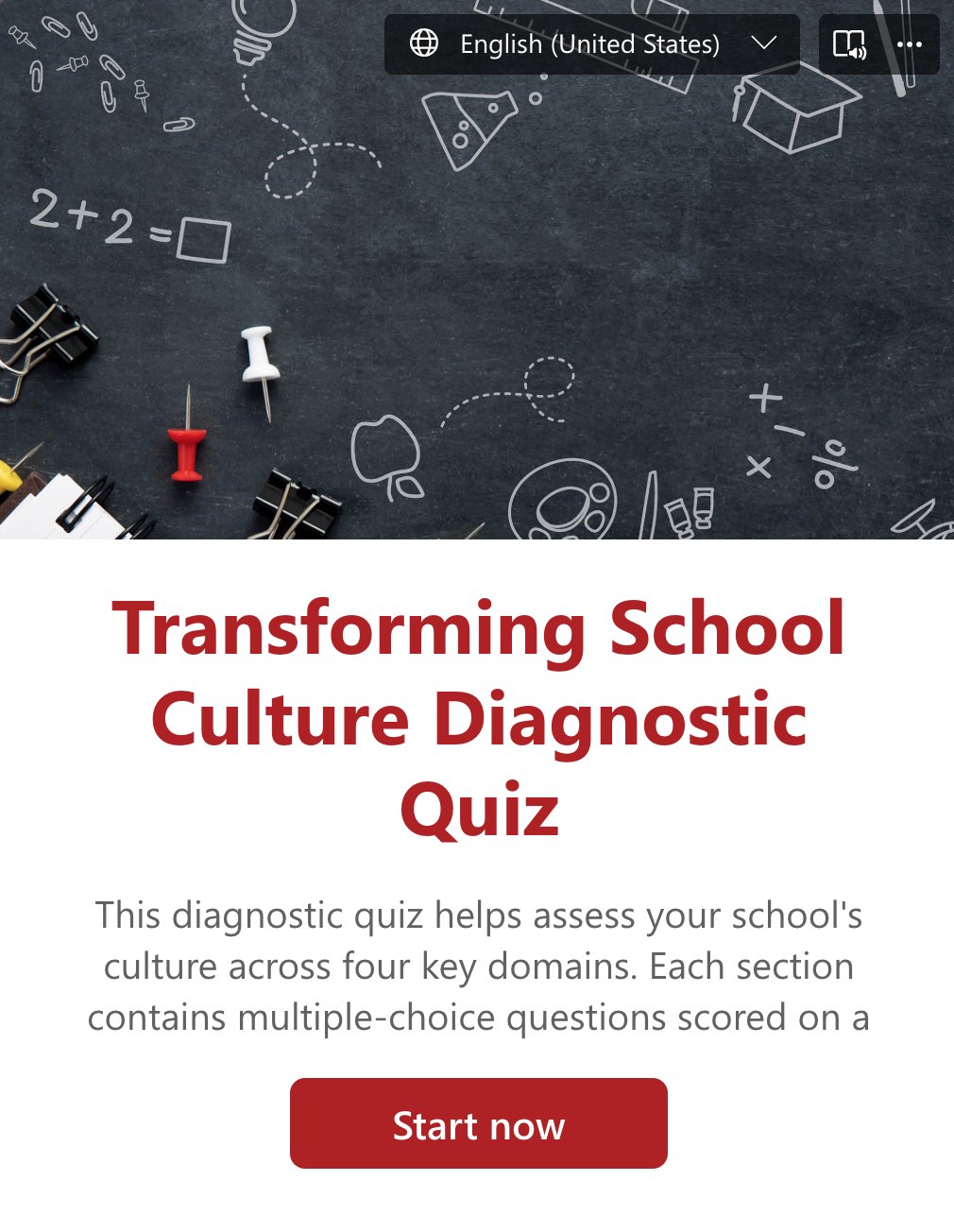
Transforming school culture
Schoolwide IB Networking Session Two
When schools cultivate belonging and expand opportunity for every student, transformation begins. Through shared vision and collaborative teamwork, communities create the culture required for deeper learning and lasting change.
Every school already has moments where collaboration works, when teachers learn from one another, when students feel connected, and when families engage with purpose. These strengths are the foundation for building a healthier school culture.
Transforming culture doesn’t mean starting over. We can improve alignment for what already exists: shared language, clear purpose, and the everyday practices that help people feel safe to contribute and learn. When a community develops a unified vision for how it works together, collaboration drives advancement of opportunities and a sense of belonging, for every student and every teacher.
These resources are intended to help schools build on their strengths through simple tools, reflection prompts, and flexible entry points. We hope they help to clarify purpose, strengthen trust, establish supportive structures, and nurture lifelong learning and learning organizations.
Your school already has what it needs to begin. Where are there opportunities to align those pieces and create a culture where it is our shared responsibility to remove barriers to learning, rather than that of individual teachers in isolation.
The Transforming School Culture Quiz is a quick, evidence-informed self-assessment that helps you understand where collaboration and culture are strongest in your school and where focused attention could create the greatest impact. It takes only a few minutes to complete and gives you an immediate sense of which areas deserve deeper investment: shared vision, structures for collaboration, relational trust, lifelong learning, or visible impact.
Self-Assessment Domains
Participants reflect on three areas:
A – Vision & Purpose (Do we have clarity of “why” and “to what end” when we collaborate?)
B – Systems & Structures (Do we have time, processes, and tools that support purposeful collaboration?)
C – Culture & Trust (Do we have relational conditions that make collaboration safe, honest, and productive?)
Once you’ve taken the quiz, the diagnostic matrix will help you interpret your results and consider practical next steps. Wherever your school is starting from, this tool gives you a clear direction for strengthening collaboration and shaping a healthier, more inclusive culture.
Schoolwide IB Committee Meeting Toolkit
The Schoolwide Committee Meeting Toolkit is a practical, ready-to-use resource designed to help leaders and teams build shared understanding, strengthen trust, and collaborate around meaningful aspects of IB learning and assessment. It provides a structured meeting agenda, excerpts from Excellence and Equity: Dimension 5, and an overview of the Language & Literature oral assessment to guide focused inquiry into how IB practices support learning variability and student success.
By working through these materials together, school teams can deepen their fluency in IB language, explore inclusive assessment design, and build confidence that a wider range of students can thrive in IB pathways. This toolkit supports the kind of purposeful collaboration that strengthens culture through clear communication, shared purpose, and collective belief in what students are capable of.
Schoolwide IB Committee Meeting Guide (.pdf)
Schoolwide Committee Meeting Agenda (.docx)
IB Excellence and Equity - Dimension 5
IB Language and Literature Individual Oral Internal Assessment (Subject Guide Excerpt)
Programme Development Plan Template - Useful for taking action
IB Programme Standards and Practices (see selected practices below)
Selected IB Programme Practices
Purpose 2: The school’s pedagogical leadership team embraces educational approaches that encourage students to become active, compassionate life-long learners. (0101-02)
Student support 4: The school provides guidance and support that help students succeed in its IB programme(s) and plan for the next stage of their educational and/or career-related experiences. (0202-04)
Teacher support 3: The school provides time and other resources for teachers to collaborate effectively in the implementation of IB programme(s). (0203-03)
Culture 1: The school secures access to an IB education for the broadest possible range of students. (0301-01)
Culture 5: The school implements, communicates and regularly reviews an assessment policy or policies to help create a culture of continuous learning and growth. (0301-05)
Coherent curriculum 2: Teachers collaborate to design, plan and deliver the school’s IB programme(s). (0401-02)
Coherent curriculum 2.2: Teachers plan and reflect collaboratively to consider connections and relationships between different areas, and reinforce shared concepts, content and skills. (0401-02-0200)
Approaches to teaching 5: Teachers remove barriers to learning to enable every student to develop, pursue and achieve challenging personal learning goals. (0403-05)
Approaches to assessment 2: The school uses assessment methods that are varied and fit-for-purpose for the curriculum and stated learning outcomes and objectives. (0404-02)
Further reading & resources
Cohen, D. K., Peurach, D. J., Glazer, J. L., Gates, K. E., & Goldin, S. P. (2013). Improvement by design: The promise of better schools. The University of Chicago Press.
Click to view this full resource
Excerpt for download (.pdf)
Goodwin, B., Cameron, G., & Hein, H. (2015). Balanced leadership for powerful learning: Tools for achieving success in your school. ASCD.
Shared vision
Bringing people together around the things they care about. When is a shared vision realized? The when in this question is very important. Shared vision takes time to cultivate, and they consist of personal visions which are “the soil nutrients” of what make up a shared vision.
Peter Senge, Introduction to shared vision (YouTube)
IB research
Published articles about the IB
Brookings (2023) Transcending borders: The International Baccalaureate’s systemic approach to educating the whole person by Whitney Hegseth
Forbes (2025) IB’s ‘Approaches To Learning’ Are Essential For The AI Era by Scott White
Forbes Excerpt: “The IB program’s ATLs are a game-changer. Unlike traditional systems that focus on rote memorization and exam performance, ATLs emphasize “learning how to learn.” This framework equips students with transferable skills such as critical thinking, collaboration, communication, and self-management. These skills are not just academic; they are life skills that enable students to adapt, innovate, and thrive in any environment.”
Related Education By Design Podcast episodes
Rewriting the school story: How spaces and narratives shape school culture
Heather Michael’s groundbreaking application of spatial theory reveals why many learners view school as irrelevant—and how educators, principals, and district leaders can disrupt limiting narratives, redesign course‑selection processes, and create inclusive, student‑centered learning spaces. Heather shares practical steps to help every student construct and own an authentic academic story with research‑backed insights, real‑world examples, and fresh inspiration to cultivate belonging, relevance, and equitable access to rigorous learning in your school community.
Listen wherever you get your podcasts
Leading schools to change through a unified vision
As a long serving principal of Dobbs Ferry High School, Dr. John Falino talks about the transformative power of systems thinking in schools. We explore practical strategies to empower teachers through shared vision, teacher agency, and systematic design to collaboratively raise expectations and engagement for all students. Learn how to build a culture of equity, align professional development with real outcomes, and create inclusive pathways that allow every learner to thrive.
Listen wherever you get your podcasts
Improvement by Design: Rethinking How Schools Change
Why do so many education reforms fall short of their promise? Dr. Joshua Glazer of George Washington University unpacks what it really takes to improve schools — not through shortcuts or silver bullets, but through the slow, steady work of building coherent, community-anchored systems.
Drawing on years of research into reform efforts, Josh explains why lasting change demands more than test scores or talent pipelines. It requires trust. Context. And above all, the capacity to learn over time.











